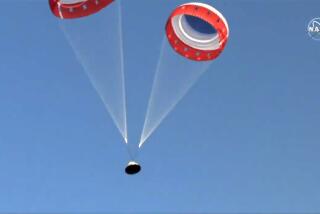A Great Leap in Space by the Soviets : Their Station Is Almost Ready While U.S. Is Still on Ground
While the nation is taken up with the aftermath of the Challenger tragedy, an event of great significance has occurred that places us 10 years or more behind the Soviet Union in space development.
That event was the Feb. 19 launching of the new Soviet space-station module. It is shortly expected to link up with the Salyut 7 spacecraft, which has been home to numerous Soviet crews during the four years that it has been circling in low Earth orbit.
Salyut 7 was the foundation of the Soviet Union’s oft-expressed bid to become the first nation to permanently occupy space. When it was launched, many Western observers were critical, calling it a small evolutionary development of the Salyut 6 that had been in space for the previous seven years. (They overlooked the fact that this is the Soviet way of developing technology--a method that this country has not yet learned but could well emulate.) Further critical comparisons were made regarding its small size and cramped crew quarters, but these were later muted when the Soviets docked a large additional module to one end of Salyut 7.
It now appears that Salyut 7, along with the earlier module and the one that was just sent up, is to become the core of the new station. The new piece, which will be attached to the other end of Salyut 7, has an additional six docking ports that allow that many more modules, or spacecraft, to be added to the station.
By Soviet accounts, at least two of these ports are to hold modules that will be especially equipped for in-space manufacturing and processing. Another, it is assumed, will be permanently occupied by an escape craft for emergency use. Unlike our Skylab and our planned new space station, the Soviets have always maintained such an escape capability on their manned stations. Other ports will hold crew modules--a very important requirement in any long-term stay in a cramped and hostile environment.
One port will always be kept free for the docking of a supply vehicle. Seven years ago the Soviets learned how to dock such craft autonomously from the ground--a feat that we have yet to accomplish. In this manner the Soviets avoid the necessity and the enormous cost of having to man their resupply vehicles. Altogether, it appears that as many as 20 people could eventually be living on the station--a number that this country will not reach for 15 to 20 more years at our present planned rate of progress.
Twenty need not be the limit, however. Add another docking facility, and you have an additional six ports . . . and so on. The modular design gives the Soviets the capability of placing any number of clusters in space wherever and whenever they want to. These can be separate or close together--the village, town or city of our future in space.
It is intrusive to compare the Salyut with our planned space station.
When it was announced by President Reagan in 1984, it was to go into operation in 1992: a new start in a new world to celebrate the 500th anniversary of Columbus’ discovery of America. Recent pronouncements from responsible members of Congress now place the initial start-up in 1996, although actual structural elements of the station will be placed in orbit two years earlier. The U.S. share of the cost of this international effort--the Western European nations, Japan and Canada are each supplying specific elements of the station--was capped at $8 billion. But recent estimates, before any metal has been cut, place the U.S. portion at closer to $12 billion.
Without questioning the very real need for a space station to help us learn to live and operate in space, we should ask whether this is the best that we can do. Twelve years and $12 billion to place six men in a high-tech tin can in space appears to be “gold plating” at its worst. Surely the world’s most advanced technological nation, with its “can do” reputation, can do better than that.
Whatever the future of our stAtion, the Salyut 7--or Mir, as the Soviets call it--represents a major step forward in humankind’s ability to both live and operate in space.
From now on, unless some unforeseen and unhoped-for emergency occurs, there will always be people living away from the Earth. That they should be Soviets may cause some people some concern at this time in history.
In the overall story of human evolution, however, it is a giant step--one that future historians and anthropologists will probably equate with our ancestral emergence from the primeval swamp. By then, one suspects, no one will really care what country the original settlers came from. But if we do care today, we have nobody to blame but ourselves. We had the capability to do this 20 years ago. If we are in a race, we should surely have learned by now that it does not necessarily go to the fleetest, nor to the strongest, but to the steadiest.
More to Read
Sign up for Essential California
The most important California stories and recommendations in your inbox every morning.
You may occasionally receive promotional content from the Los Angeles Times.










